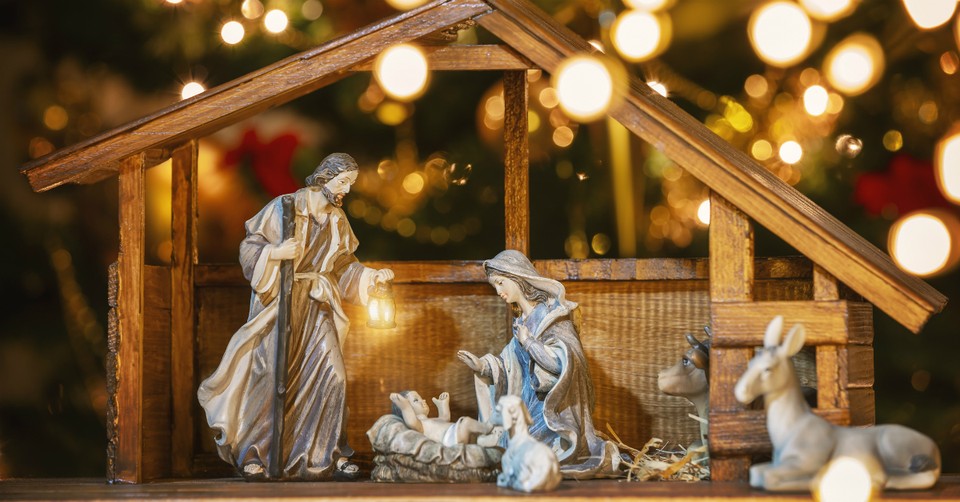Christmas Possibilities from Story of Christ's Birth

'Tis the season when most Christians reflect on the birth of our Lord and Savior Jesus. But we should always keep in mind that many Christmas traditions are not well supported by evidence, such as the Bible or any other reliable sources. As Christian families, we all want to cultivate critical thinking in our kids. We can start by considering some of the facts and fancies about Christmas.
The Nativity Scene
Perhaps the primary symbol of Christmas is the nativity scene. In this season, we always see depictions Baby Jesus in the stable with Mary and Joseph. Animals such as donkeys are all around and the shepherds are there with their sheep. And two weeks later, on the Feast of the Epiphany, the Three Kings are added to the nativity scene.
We've all grown up with this holiday tradition. But there is little Biblical evidence to support this familiar picture. The Gospel of Luke describes the birth of Jesus and the visitation by the shepherds. The text in Luke 2:7 simply says:
"And she brought forth her firstborn son, and wrapped him in swaddling clothes, and laid him in the manger; because there was no room for them in the inn."
Notice that this text does not describe a "stable" with animals all around. A manger is a feeding trough, not a stable as many people believe. While it does seem that a manger would most likely be found in a stable, it could also have been outside. So Jesus could well have been born in the street. At any rate, the text isn't clear on this particular point, and the Christmas story is enshrouded with tradition.
In Bethlehem, there is a church called the Church of the Nativity, traditionally regarded as the site of Jesus' birth. This church is inside an underground cave where animals had purportedly been kept in the First Century. The Church of the Nativity was built in the Fourth Century by the Emperor Constantine and is one of the oldest surviving Christian churches.
The familiar "creche," i.e. the stable nativity scene, is attributed to Francis of Assisi, who lived in the 13th century. Francis had made a nativity scene using live people and animals, including a real baby. And Francis's tradition has survived today, defining our familiar image of the Nativity.
The Magi
The second chapter of the Gospel of Matthew is the text that discusses the "Three Kings." But the text in Matt 2:1 and other verses only says that they were "wise men from the east." It doesn't say that they were kings, nor does it say that there were only three. The number three might be because of the three gifts they brought. Also, neither does the text say that they were astrologers, nor that they were "magi," which is to say "users of magic." And the account says that they went to the "house" where Mary, Joseph and Jesus were, not the "stable," which at least suggests that this visitation was at a later time after Jesus' birth.
Over the centuries, these traditions had become increasingly embroidered, departing further and further from the strict Biblical account. But these traditions are not necessarily wrong. Our family enjoys traditions as much as anyone, and they are a part of our traditional Christmas celebration. These thing are only pointed out to encourage everyone to critically inquire about things we hear and learn. We should learn to seek out specific evidence for truth and take care to distinguish the wheat from the chaff.
The Star of Bethlehem
For example, at this time of year, one often hears explanations of the Star of Bethlehem. Many people would like to reconcile the Biblical account with modern science. One might like to say that there was a transient celestial event like a supernova, a star that burned brightly for a time and then dimmed down. Unfortunately for this notion, there are no recorded sightings of such an event from the time in question. Also, according to such theory, a supernova would have left a nebula behind as a remnant. No such nebulae are available that would fit both the Biblical account and the astronomical requirements.
It seems that nearly every year, someone floats a new theory to explain and rationalize the Star. One popular theory notes that Halley's Comet would have visited Earth in 12 AD, and that this was the Star of Bethlehem. There is even a painting of the nativity that shows a comet in the sky above the stable. Another recent theory would suggest that there was a conjunction (or grouping) of several bright planets that occurred near the time of Jesus' birth. This conjunction would have had astrological significance suggestive of a royal portent that would have been understood by "magi" and "astrologers" of the time.
The problem with these and any other such theories is that there is no way to prove any of them one way or other. In this writer's opinion, the Star of Bethlehem was a strictly supernatural event. For one thing, in the brief description in the Biblical account, the Star does not seem to behave like a natural star, rising and setting over the span of a night. In any case, we should be wary of attempts to provide a natural, scientific explanation for everything in the Bible. In so doing we would subordinate God's Word to the shifting sands of scientific methodology, and grant human reasoning greater authority than Scripture.
Even if we could establish a specific natural event for the Star of Bethlehem, the problem is complicated by the fact that we don't know exactly when Jesus was born. This is ironic since we know the birth dates of many others from antiquity, such as Alexander the Great and Julius Caesar. In fact, other than some sparse references from the writings of Flavius Josephus and Pliny the Younger, there are really no literary sources outside of the Bible that even discuss Jesus himself. It is ironic that Jesus is the most important person in history and yet the least documented.
Dating the Birth of Jesus
In our common calendar, Jesus' birth should have occurred in the year 1 AD. This date was determined by a Roman monk named Dionysius Exiguus in 532 AD. Like many, Dionysius was aware that the phases of moon would recurrently fall on the same days of the week in a cycle of 19 years. He also noted that with the four-year "leap year" cycle, the solstices and equinoxes would fall on the same days of the week every 28 years (4 years times 7 days in a week). So Dionysius proposed that the Moon's phases and the seasons would both recur on the same weekdays in a cycle of 532 years (19 times 28 years).
For some reason unknown to us today, Dionysius simply proclaimed that the year he proposed his calendar was at the end of a cycle that began in the year of Jesus' birth. There is no evidence as to whether Dionysius had a source for this assertion, or if he just made it up. But Dionysius' cycle was not commonly used until it was promoted by the Venerable Bede around 700 AD. Bede wrote:
"But Dionysius, a venerable abbot of Rome... chose instead to designate the years from the Incarnation of our Lord Jesus Christ, so that the source of our hope might be the more evident to us, and that the cause of man's restoration, that is, our Redeemer's Passion, might be more clearly manifest."
And this was the beginning of counting the years according to Anno Domini (A.D), "the Year of Our Lord." It was certainly a noble purpose, but we find no critical evidence from either Dionysius or Bede to authoritatively date the birth of Jesus.
The most popular historical theory says that Jesus was actually born in 4 BC. This year would have been the 750th year since the founding of Rome and the 25th year of the reign of the Emperor Caesar Augustus. So for these reasons and other, the experts think that this year was a cause for celebration by Augustus, and therefore a more likely time to issue a decree "that all the world should be taxed," as we read in Luke 2:1. Maybe so, but maybe no. This is a reasonable scholarly inference, but again there is no specific hard evidence.
Most folks would agree that Jesus was not born around the winter solstice, which is when we celebrate Christmas. After all, we read in Luke 2:8 that the shepherds were tending the fields at the birth of Jesus. I've read that the shepherds only stayed out at night with the sheep in the spring, when baby lambs were being born. This is a neat picture, since Jesus, as the Lamb of God, would have been born in the season of the natural lambs. Others make arguments for other seasons, but again, the text of Scripture offers no clue as to the season.
I've read that the celebration of Christ's Nativity was not even observed in the early church, that developed in the Second Century. We often hear comments to the effect that our modern holiday of Christmas was derived from pagan solstice celebrations. For centuries, the Romans celebrated a holiday called the Saturnalia near the winter solstice. In the later centuries, a Persian celebration of the "Unconquered Sun" was observed in Rome, also around the time of the solstice.
But the fact is, there are no documented sources that help establish exactly when a late December holiday of Christ's nativity became a Christian holiday. Nor are there any specific sources to suggest that pagan holidays were "baptized" into our traditional Christmas observance. There are other Christian traditions that appear similar to pagan customs, like Easter eggs and bunnies. But while the timing of Christmas near the solstice is indeed too remarkable to appear coincidental, this idea is just another popular scholarly inference, not supported by direct evidence.
Each year Christian parents explain "The Santa Myth" to their kids. But we see that even the story of Jesus has some "urban legends" that make the rounds every year. As we see from the Christmas story, sometimes we don't know as much about things as we think! In the coming year, perhaps each homeschool family should make it a point to turn a critical eye toward things we read and hear. We ought to teach our kids to inquire as to "how do we know what we think we know," and place our faith and hope accordingly.
Jay Ryan is the creator of "The Classical Astronomy Update," a free e-mail newsletter for helping Christian homeschool families learn more about what's up in the starry sky. Also, you can visit the Classical Astronomy web site - www.ClassicalAstronomy.com .
photo credit: ©GettyImages/manaemedia
Originally published August 27, 2024.







